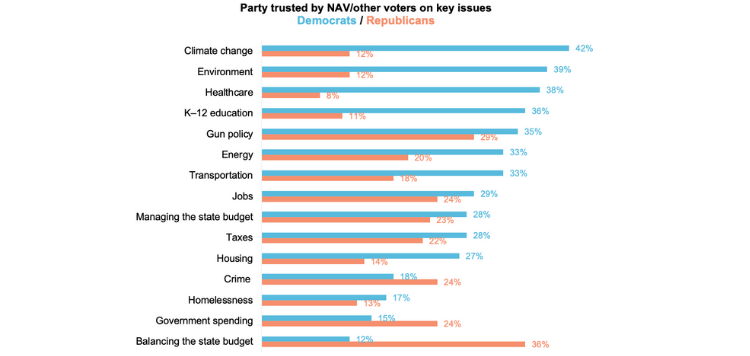DHM Panel November 2019 Survey Results
December 10, 2019
For last month’s DHM Panel Survey, we took our first look at how opinions are shaping up for next year’s elections. To learn voters’ priorities, we presented panelists with a list of fifteen issues and asked them to choose the three that will be the most important to them when choosing which candidates to vote for in the 2020 Oregon state legislative elections.
These findings come from the November 2019 fielding of our DHM Panel. The survey was conducted from November 13 to 19, 2019, and surveyed 582 Oregonians. The results were weighted by age, gender, area of the state, political party, and level of education to ensure a representative sample of Oregon voters. The margin of error for this survey ranges from ±4.1% to ±4.3%.
Democrats, Republicans and NAV/other voters have different priorities.

Democrats’ top five priorities are climate change, healthcare, environment, homelessness and housing. Among these, just one (homelessness) is one of the top five priorities for Republicans, and only two (healthcare and environment) are in the top five for NAV/other voters.
For Republicans, the top issues include government spending, taxes, gun policy, managing the state budget and homelessness. The top issues for NAV/others are healthcare, taxes, K–12 education, government spending, and the environment.
Jobs and K–12 education are now lower priorities for many voters.
A couple other notable findings are the relatively low prioritization of jobs and K–12 education. In past years, especially during the height of the Great Recession, jobs was consistently the top issue among voters of all political stripes. Historically, too, K–12 education has been a top issue for voters. Here it was the third-rated issue for NAV/other voters, but sixth for Democrats and tenth for Republicans. The relatively low rating of K–12 education could be a result of other issues becoming more urgent to address. It could also be the result of the passage of the Student Success Act, which will add $1 billion per year of new spending to K–12 education. With the new funding, perhaps K–12 education is no longer as urgent of a priority.
Non-affiliated and third-party voter have more trust in Democrats than Republicans on most issues.

NAV/other voters are a rapidly increasing share of the Oregon electorate. They now represent 40% of Oregon voters, compared to registered Democrats (35%) and registered Republicans (25%). Despite this increase in NAV/other voters, all 90 of Oregon’s legislators are Democrats and Republicans. Knowing which party NAV/others trust more on the issues can provide some early insight into 2020 elections.
Among the fifteen issues, we asked all survey participants to indicate if they generally trust the Democratic or Republican party more. Among NAV/other voters, they indicated they trust the Democratic party more on twelve of the issues. The only three that they trusted the Republican party more were government spending, balancing the state budget, and crime. The issues for which they tend to trust the Democrats most were climate change, environment, healthcare, and K–12 education.
